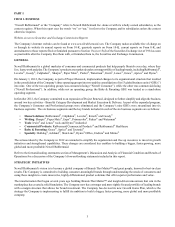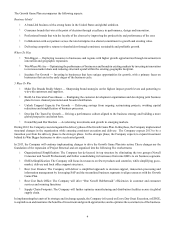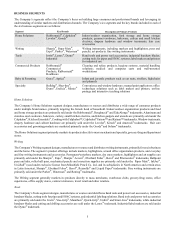Graco 2012 Annual Report Download - page 19
Download and view the complete annual report
Please find page 19 of the 2012 Graco annual report below. You can navigate through the pages in the report by either clicking on the pages listed below, or by using the keyword search tool below to find specific information within the annual report.13
the terms of the policy.
If the Company is unable to access the capital markets to refinance its maturing debt, its borrowing costs could increase.
As of December 31, 2012, the Company had $211.9 million of debt that it will be required to refinance or repay within the next
12 months. It is possible that the Company may seek to address its short-term obligations through the capital markets or other
arrangements. However, access to the capital markets cannot be assured, and although the Company believes that alternative
arrangements will be available to refinance these obligations, such arrangements could result in an increase in the Company's
borrowing costs.
A reduction in the Company's credit ratings could materially and adversely affect its business, financial condition and
results of operations.
The Company's current senior debt credit ratings from Moody's Investors Service, Standard & Poor's and Fitch Ratings are Baa3,
BBB- and BBB, respectively. Its current short-term debt credit ratings from Moody's Investors Service, Standard & Poor's and
Fitch Ratings are P-3, A-3 and F-2, respectively. Moody's, Standard & Poor's and Fitch have a stable outlook on their ratings. The
Company cannot be sure that any of its current ratings will remain in effect for any given period of time or that a rating will not
be lowered by a rating agency if, in its judgment, circumstances in the future so warrant. A downgrade by Moody's or Standard &
Poor's, which would reduce the Company's senior debt below investment-grade, could increase the Company's borrowing costs,
which would adversely affect the Company's financial results. The Company would likely be required to pay a higher interest rate
in future financings, and its potential pool of investors and funding sources could decrease. If the Company's short-term ratings
were to be lowered, it would limit, or eliminate entirely, the Company's access to the commercial paper market. The ratings from
credit agencies are not recommendations to buy, sell or hold the Company's securities, and each rating should be evaluated
independently of any other rating.
The level of returns on pension and postretirement plan assets and the actuarial assumptions used for valuation purposes
could affect the Company's earnings and cash flows in future periods. Changes in government regulations could also affect
the Company's pension and postretirement plan expenses and funding requirements.
The funding obligations for the Company's pension plans are impacted by the performance of the financial markets, particularly
the equity markets, and interest rates. Funding obligations are determined under government regulations and are measured each
year based on the value of assets and liabilities on a specific date. If the financial markets do not provide the long-term returns
that are expected under the governmental funding calculations, the Company could be required to make larger contributions. The
equity markets can be, and recently have been, very volatile, and therefore the Company's estimate of future contribution
requirements can change dramatically in relatively short periods of time. Similarly, changes in interest rates and legislation enacted
by governmental authorities can impact the timing and amounts of contribution requirements. An adverse change in the funded
status of the plans could significantly increase the Company's required contributions in the future and adversely impact its liquidity.
Assumptions used in determining projected benefit obligations and the fair value of plan assets for the Company's pension and
other postretirement benefit plans are determined by the Company in consultation with outside actuaries. In the event that the
Company determines that changes are warranted in the assumptions used, such as the discount rate, expected long-term rate of
return on assets, or expected health care costs, the Company's future pension and postretirement benefit expenses could increase
or decrease. Due to changing market conditions or changes in the participant population, the assumptions that the Company uses
may differ from actual results, which could have a significant impact on the Company's pension and postretirement liabilities and
related costs and funding requirements.
ITEM 1B. UNRESOLVED STAFF COMMENTS
Not applicable.
























